Xeon Marks The Spot At Intel's Nehalem Launch
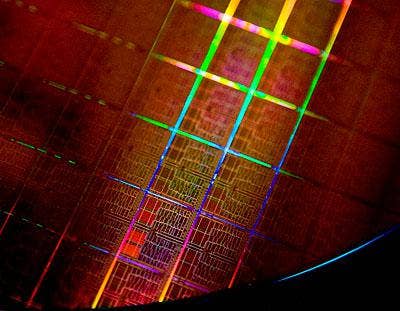
Intel made its case for transforming the data center Monday, launching its Nehalem-class Xeon 5500 and 3500 series of server chips with its entire ecosystem in tow at the chip maker's Santa Clara, Calif., campus.
More than 70 vendors and white-box builders were ready on launch day with some 230 new products built around the benchmark-busting processor, leading Intel to proclaim its new products -- seen here on a silicon wafer -- "transformational."
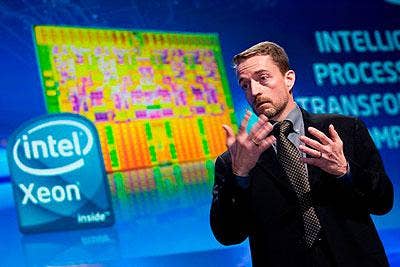
Pat Gelsinger promised that the chip giant's new two-socket server processors don't just represent another check ticked off on Intel's famously ambitious product road map. "It's not about next year's product, it's not last year's," said the senior vice president and general manager of Intel's Digital Enterprise Group, here delivering his keynote at the launch event. "This processor is the big one."
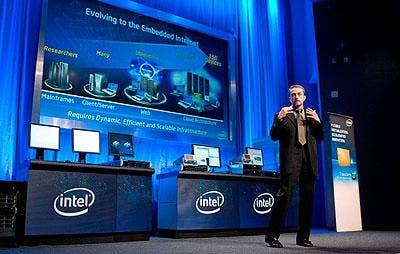
Intel hit the market with 17 new enterprise-class server/workstation processors based on its Nehalem microarchitecture, including 14 dual-core and quad-core chips in the Xeon 5500 series ranging in price from $188 to $1,600 for 1,000-unit orders, and three in the Xeon 3500 series available for $284, $562 and $999. The new lineup marks the return of Intel's hyper-threading for improved core performance and a new feature called Turbo Boost -- a kind of circuit breaker that dynamically manages power on individual processor cores -- which Gelsinger described as "wicked cool technology."
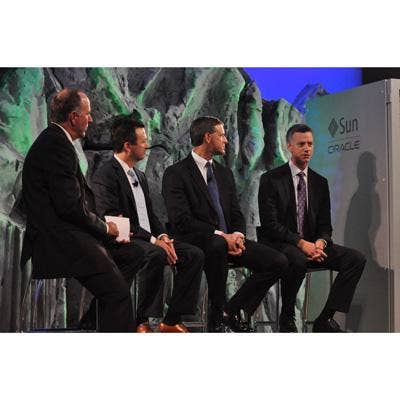
Pat Gelsinger moderates a panel of Intel customers during Monday's Nehalem launch event at the Intel campus in Santa Clara, Calif., including representatives from BP, eBay and DreamWorks. Regarding the new server chips' benefits, Josh Crowe of outsourced IT infrastructure provider Savvis, third from left, said his company would take advantage of both the performance gains and cost-cutting benefits offered by the Xeon 5500 series. According to Gelsinger, a one-for-one swap of older single-core Xeon servers for Nehalem-based systems would deliver nine times the performance in the data center, while replacing those older servers with less than an eighth the number of Nehalem systems that would get you the same performance, but with a 90 percent reduction in energy costs.
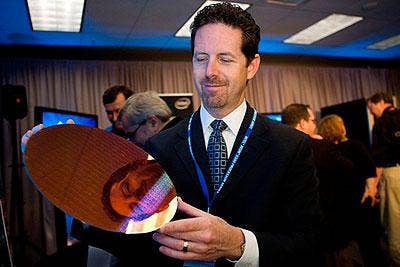
Doug Davis, a vice president in Intel's Digital Enterprise Group and general manager of its Embedded and Communications Group, brandishes a Nehalem silicon wafer at Monday's event. The product release included two Xeon 5500 series chips for the embedded and communications market, including the 2.0GHz, 38-watt Xeon L5508 priced at $423 per unit in 1,000-unit shipments.
Davis said he believed IT spending plans in the U.S. government's multibillion-dollar stimulus package could mean that the overall public-private mix of 5500 series purchases could start skewing towards public-sector orders -- particularly with regards to the new embedded devices -- in the initial phase of the Nehalem rollout in the US. Intel is actively exploring stimulus bids with its partner channel, he said.
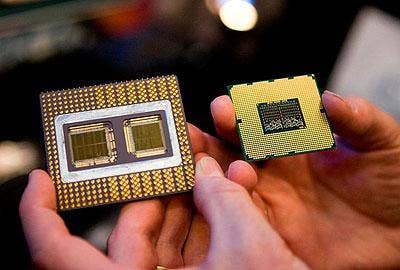
"This is the most important server launch we have done since the Pentium Pro in 1995," said Pat Gelsinger, adding that Intel's new Xeon 5500 series represented "the greatest leap in history of performance of server processors." Hyperbole? Perhaps, considering that the new chip -- seen here at right next to the Pentium Pro, Intel's first server workload-optimized processor -- has been released for all of one day.
On the other hand, the new devices have already smashed 30 benchmarking records for two-socket server processors (and even a few four-socket records). Many records fell by eye-opening margins -- 64 percent, 87 percent and even a 160 percent improvement over the previous record-holder on VMware's VMmark -- were numbers that flashed on the screen during Gelsinger's presentation.
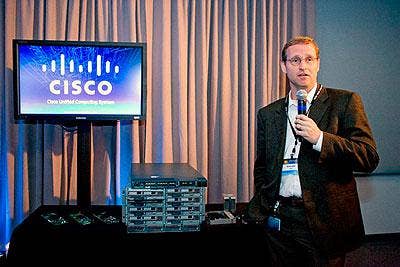
Major system vendors on hand for Intel's Nehalem launch included Hewlett-Packard, Dell, IBM, Sun Microsystems -- and networking giant Cisco, a new entrant in the server market. Here, David Lawler, vice president of product marketing at San Jose, Calif.-based Cisco, describes the company's lineup of Nehalem-based servers and Unified Computing System framework for penetrating the data center. In April, Cisco will be releasing a blade server that further extends the system memory of the already formidable Xeon 5500 series of processors, Lawler said.
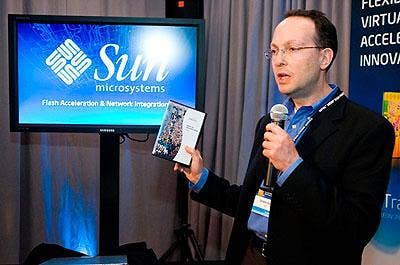
Sun Microsystems won't ship its first Nehalem-based servers until April 14, but the Santa Clara, Calif.-based company has worked overtime tweaking its Solaris and Open Solaris operating systems to coincide with the Nehalem launch, as outlined here by Dimitris Dovas, director of systems marketing for Sun's x64 Volume Systems unit. "We've done things like develop what we call Predictive Self-Healing in Solaris, so if you get a system panic due to a problem with one of the cores, Solaris can take that core out of the system," said Herb Hinstorff, Sun's director of business management, in an earlier interview with ChannelWeb.com
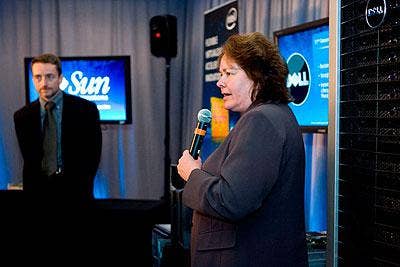
Dell's new ready-to-ship Xeon 5500-based servers numbered five, including a two-socket tower server, 1U and 2U rack-mount servers with two sockets, and half-height and full-height blade servers. All of the systems feature a pair of new Dell-built server image and system management tools -- called Image Direct for Servers and LifeCycle Controller, respectively -- and all are channel-ready, according to Sally Stevens, director of platform marketing at Round Rock, Texas-based Dell. "We've done extensive training of the channel," said Stevens, shown here pitching the Dell message at the Nehalem launch as Intel's Pat Gelsinger looks on. "The channel has become mainstream at Dell as we launch new platforms. Eventually the new servers will be available through distribution, but we need to check the timing."
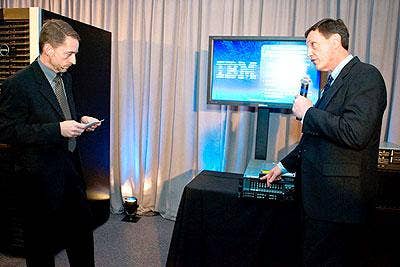
How serious is Intel's ecosystem about Nehalem? IBM has historically been in no great rush to push out servers based on new x86 processors, but on Monday the Armonk, N.Y.-based computing giant unveiled four Xeon 5500-based units that are available now. "There's a lot of talk out there that IBM isn't committed to x86, but this proves that isn't true," said Bob Galush, vice president for IBM's System x unit, seen here, at right, touting his company's wares as Intel's Pat Gelsinger listens. A simplified IBM System Director management suite for multiple virtualized server environments is a big part of the vendor's Nehalem-based lineup, which includes a pair of rack-mount servers, the new IBM BladeCenter HS22 and the System x iDataPlex dx362 M2 for extra performance.